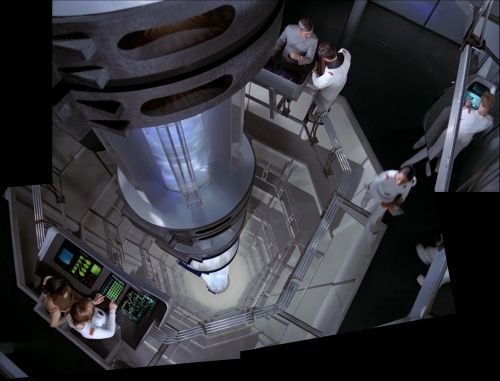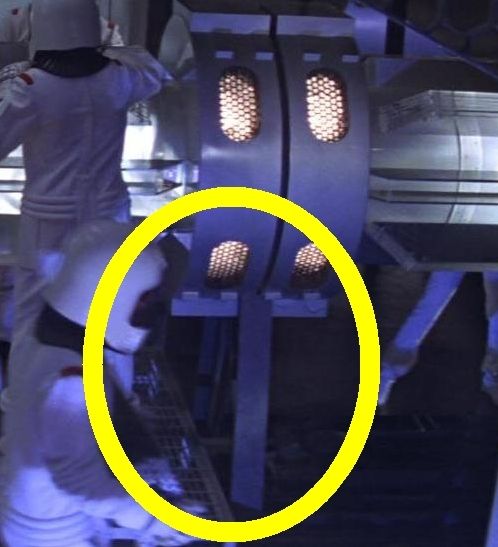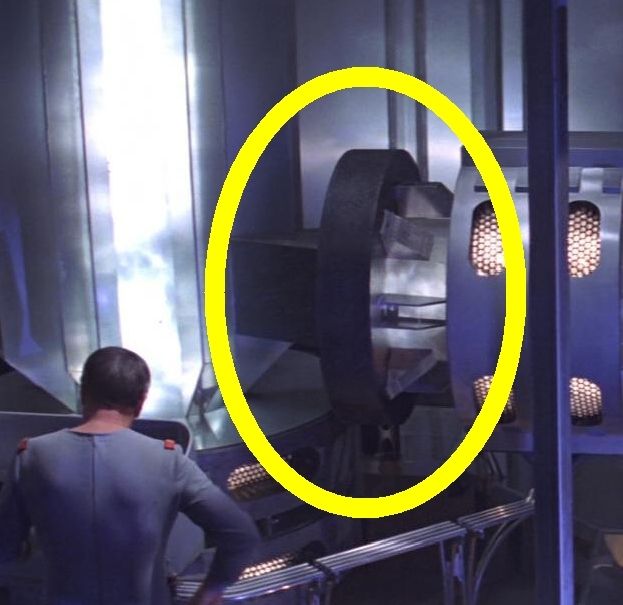The power taps for the saucer can be up near the impulse deflection crystal, since that goes unseen. I suppose we could argue that the secondary hull power taps are also above where we see Kirk enter Engineering in TMP, perhaps at the level where the photon torpedo tubes are. This then allows the position of the main panel at the branching point be ideal for deciding how the power gets distributed between the warp drive and the rest of the ship.That's the difference between TMP and TWOK. TMP's makers had some concern for plausibility and internal logic, while TWOK's makers did not. So their additions to the engine room make no sense.
Although, granted, TMP's designs aren't perfect. What gets me about the intermix chamber is that its only connections to anything outside itself are to the reactant tanks at the base, the impulse deflection crystal at the top, and the warp engines at the rear. There are no discernible connections between the intermix shaft and the ship's power systems. So how does it power the phasers, or the deflector dish, or the ship in general?
-
Welcome! The TrekBBS is the number one place to chat about Star Trek with like-minded fans.
If you are not already a member then please register an account and join in the discussion!
You are using an out of date browser. It may not display this or other websites correctly.
You should upgrade or use an alternative browser.
You should upgrade or use an alternative browser.
Warp Core: TMP and TWOK
- Thread starter topcat
- Start date
It is an unfortunate result of the ultra-"sleek'n'futuristic" design. However, the single POV shot we get:What gets me about the intermix chamber is that its only connections to anything outside itself are to the reactant tanks at the base, the impulse deflection crystal at the top, and the warp engines at the rear. There are no discernible connections between the intermix shaft and the ship's power systems. So how does it power the phasers, or the deflector dish, or the ship in general?

...shows that most of the aft portside area is obscured (by the vertical power shaft). Maybe this area is where all the power taps and associated gubbinz are located?
In addition, it would mean that Spock's Death Room is located almost directly above all this stuff!
The exact quote is:didn't Barclay or geordi say the phoenix was just like the enterprise, just more simplistic?
So, they learned about them in history class at university, essentially - much as we might learn about George Stephenson's Rocket as an ancestor to the modern automobile, but while the two technologies produce locomotion through similar means (heating a liquid), the specifics are very different. As it is with the Phoenix and the Enterprise-ELAFORGE: I've tried to reconstruct the intermix chamber from what I remember at school. Tell me if I got it right.
COCHRANE: School? You learned about this in school?
LAFORGE: Oh yeah. 'Basic Warp Design' is a required course at the Academy. The first chapter is called 'Zefram Cochrane'
The same level to port is also fairly well masked. There's loads of space for extra conduits!Directly aft on the lower levels is also obscured, so they could be there as well.

...shows that most of the aft portside area is obscured (by the vertical power shaft). Maybe this area is where all the power taps and associated gubbinz are located?
Directly aft on the lower levels is also obscured, so they could be there as well.
The same level to port is also fairly well masked. There's loads of space for extra conduits!
Uh-oh... I think we're on the verge of a time loop. Vent the main shuttlebay, quick!
Or just poorly worded dialogue. Assuming the forward area of the ship is North, I originally pointed out the Southwest area. Then DRT added South, and I added West.
Always happy to see the main shuttlebay thought!
The good thing is; the TMP tech allows "taps" into the main vertical conduit at any stage along its length, not specifically at the junction points:

Always happy to see the main shuttlebay thought!

The good thing is; the TMP tech allows "taps" into the main vertical conduit at any stage along its length, not specifically at the junction points:

The good thing is; the TMP tech allows "taps" into the main vertical conduit at any stage along its length, not specifically at the junction points:
I thought of that, but the support frameworks seem too flimsy to contain power transfer conduits.
Unless the extra transfer conduits themselves form part of the support framework for the column?I thought of that, but the support frameworks seem too flimsy to contain power transfer conduits.
That's certainly a more interesting explanation that the usual "that's where the turboshaft goes".I'm not sure we ever got a good look at the starboard side of the horizontal shaft, could postulate taps along there as well, which could maybe explain the asymmetry of the long Engineering hallway only having an inspection walkway running down the port side.
And indeed, we never see clearly beyond the first 4 segments, so why not?
Unless the extra transfer conduits themselves form part of the support framework for the column?
But that's just my point -- given how hefty the PTCs were shown to be in TNG, DS9, and VGR, the support frame components in TMP look far too small to have PTCs inside them.
Given that we saw M5 draw power in a very visible yet wireless way, perhaps the "taps" here are wireless as well,
Interesting thought, but again, it's hard to reconcile with the TNG-era designs.
Ah, I think we are talking cross-purposes here - I think you are referring to the legs of the horizontal power conduit, am I right?But that's just my point -- given how hefty the PTCs were shown to be in TNG, DS9, and VGR, the support frame components in TMP look far too small to have PTCs inside them.

If so I agree that they are far too slender to house power taps
However, I was talking about the one conduit connection we do see:

Notice that it is just inserted straight into the crystalline part of the vertical power shaft (not the dark disc sections as one might expect). As a result, we can imagine any number of these horizontal conduits on the decks below the main Engine Room, allowing energy to be sent to any of the ship's systems that might require it.
...And moreso on decks above the level of the set, as we have no bloody idea what the core does above that level.
Indeed, if there's one thing that can be counted out, it's the core continuing straight up the same way it mattes down. Tilting forward to follow the angle of the neck until meeting with the impulse engine is a possibility. Immediately truncating in a doodad is a somewhat likelier one. And that doodad could just as well be a universal power converter of some sort, although if these tubes really hold and convey antimatter, it could be the torpedo loader, too.
Timo Saloniemi
Indeed, if there's one thing that can be counted out, it's the core continuing straight up the same way it mattes down. Tilting forward to follow the angle of the neck until meeting with the impulse engine is a possibility. Immediately truncating in a doodad is a somewhat likelier one. And that doodad could just as well be a universal power converter of some sort, although if these tubes really hold and convey antimatter, it could be the torpedo loader, too.
Timo Saloniemi
The connection is also triangular and looks like it tapers down too much to actually transfer much of anything - which is why I like how Christopher imagined it as being a small transfer tube surrounded by thick shielding in Ex Machina.Ah, I think we are talking cross-purposes here - I think you are referring to the legs of the horizontal power conduit, am I right?

If so I agree that they are far too slender to house power taps
However, I was talking about the one conduit connection we do see:

Notice that it is just inserted straight into the crystalline part of the vertical power shaft (not the dark disc sections as one might expect). As a result, we can imagine any number of these horizontal conduits on the decks below the main Engine Room, allowing energy to be sent to any of the ship's systems that might require it.
Makes sense - those perspex wings are already just bulking out a relatively thin central column - the actual interior capacity of which can't be all that big.The connection is also triangular and looks like it tapers down too much to actually transfer much of anything - which is why I like how Christopher imagined it as being a small transfer tube surrounded by thick shielding in Ex Machina.
Yeah, but I would feel better if the power supply for the main deflector could take a somewhat less meandering route (than up, along, down again)...And moreso on decks above the level of the set, as we have no bloody idea what the core does above that level.
Indeed, if there's one thing that can be counted out, it's the core continuing straight up the same way it mattes down. Tilting forward to follow the angle of the neck until meeting with the impulse engine is a possibility. Immediately truncating in a doodad is a somewhat likelier one. And that doodad could just as well be a universal power converter of some sort, although if these tubes really hold and convey antimatter, it could be the torpedo loader, too.
Or, does that particular power feed separate off at the reactor level, before the main vertical column even starts?
The connection is also triangular and looks like it tapers down too much to actually transfer much of anything - which is why I like how Christopher imagined it as being a small transfer tube surrounded by thick shielding in Ex Machina.
I figured it had to be in order for the matter-antimatter reaction to happen at all. After all, deuterium and antideuterium nuclei are pretty tiny. Let them bounce around a big space like that and they'll mostly miss each other, even with the swirl-chamber design that gives them multiple opportunities to collide. A more compact cylinder that concentrated the reactants more seemed like the best way to go. Also, the light from an ongoing matter-antimatter reaction would presumably be blinding, so what we're seeing must be just the barest fraction of it, so the chamber walls must be thick enough to filter out nearly all the light.
Yeah, but I would feel better if the power supply for the main deflector could take a somewhat less meandering route (than up, along, down again)
Or, does that particular power feed separate off at the reactor level, before the main vertical column even starts?
I addressed the lack of a warp reactor-deflector dish connection in Department of Temporal Investigations: Forgotten History by establishing that the deflector dish had a dedicated fusion reactor of its own. This was informed by Doug Drexler's Enterprise cutaway for "In a Mirror, Darkly," which includes a massive set of power transfer conduits connecting the warp reactor to the deflector dish; I remember reading that his rationale was that the deflector would need to emit an enormously powerful beam to deflect interstellar debris effectively, given the velocities and energies involved. So in his cutaway design (which was shown onscreen, so I consider it authoritative), the PTCs took up a huge amount of the engineering hull's volume. I figured that giving the deflector dish a dedicated reactor would clear up space in the secondary hull, which would help explain why the refit's hangar and cargo facilities are so spacious.
Similar threads
- Replies
- 9
- Views
- 810
- Replies
- 13
- Views
- 2K
- Replies
- 0
- Views
- 246
If you are not already a member then please register an account and join in the discussion!
